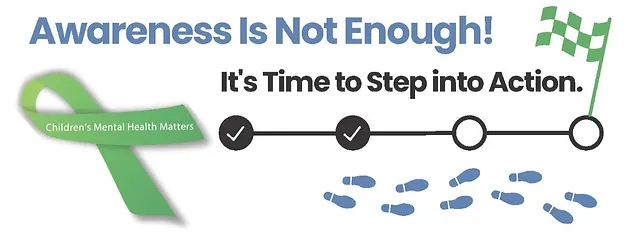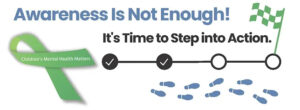
by Beth Ayers, Family Peer Support Lead
May 2, 2023
The U.S. Surgeon General in his 2021 Advisory: Protecting Youth Mental Health stated, “Every child’s path to adulthood- reaching developmental and emotional milestones, learning healthy social skills, and dealing with problems- is different and difficult. Many face added challenges along the way, often beyond their control. There’s no map and the road is never straight. But the challenges today’s generation of young people face are unprecedented and uniquely hard to navigate. And the effect these challenges have had on their mental health is devastating.” He goes on to say, “Mental health challenges in children, adolescents, and young adults are real, and they are widespread. But most importantly, they are treatable, and often preventable.”
But before prevention comes acceptance. Before we can accept that mental health is important and affects our kids, we have to acknowledge it, talk about it, and address the issues surrounding it. We have to fight against the stigma. We have to recognize mental illness as the physical illness it is and not a character defeat.
 The 2021 Montana Youth Risk Behavior Survey reported that “among high school students, 41% have felt so sad or hopeless for two or more weeks in a row that they stopped doing usual activities” and “22% seriously considered attempting suicide.” These numbers are staggering! My question is, what are we as Montanans doing about this? Are we even aware that our kids are struggling? Are there programs in the schools to address this? Do teachers and other students feel prepared to support the 41%? Do communities or schools have mental health support groups for youth? Can a student take a mental health day just like taking a sick day for any other illness? And if we are doing these things, is it enough? Are we addressing children’s and youth’s mental health openly and without judgement? Do we know, accept, and treat mental illness as the physical illness is it? Do we believe mental illness is treatable and that people with it can lead healthy and satisfying lives?
The 2021 Montana Youth Risk Behavior Survey reported that “among high school students, 41% have felt so sad or hopeless for two or more weeks in a row that they stopped doing usual activities” and “22% seriously considered attempting suicide.” These numbers are staggering! My question is, what are we as Montanans doing about this? Are we even aware that our kids are struggling? Are there programs in the schools to address this? Do teachers and other students feel prepared to support the 41%? Do communities or schools have mental health support groups for youth? Can a student take a mental health day just like taking a sick day for any other illness? And if we are doing these things, is it enough? Are we addressing children’s and youth’s mental health openly and without judgement? Do we know, accept, and treat mental illness as the physical illness is it? Do we believe mental illness is treatable and that people with it can lead healthy and satisfying lives?
The U.S. Surgeon General goes on to say, “Ensuring health children and families will take an all-of-society effort, including policy, institutional, and individual changes in how we view and prioritize mental health. Our obligation to act is not just medical- it’s moral.” The Advisory states that “each of us has a role to play” and lists ways to take action.
The first way listed is to “Recognize that mental health is an essential part of overall health.” I love the statement the Advisory makes about this: “Mental health conditions are real, common, and treatable, and people experiencing mental health challenges deserve support, compassion, and care, not stigma and shame.” As a parent who has raised a child who experiences mental health challenges, this hits home. Too often mental health challenges are assumed to go away on their own or they can be “cured” with changes in parenting style. Even well-meaning suggestions for how to “fix” my child’s mental illness has left me feeling alone and misunderstood. As a parent I would have rather been listened to and accepted and encouraged to seek medical help as I assume people would have done had I been talking about a physical ailment.
Another way the Advisory says we can take action is to “Empower youth and their families to recognize, manage, and learn from difficult emotions.” We can create an environment that is safe for families and youth to express how they’re feeling and offer support and validation. We can also share our experience and hope. We can help others develop a mental health tool box where they can add tools to help them such as self-care practices, the 8 Dimensions of Wellness, crisis planning, natural supports, and mental health education. The 8 Dimension of Wellness include social, emotional, spiritual, intellectual, physical, environmental, financial, and occupational. The dimensions are interconnected and being healthy in many dimensions of our lives leads to overall wellness. For more information on the 8 Dimensions of Wellness, visit samhsa.gov for SAMHSA’s workbook titled “Creating a Healthier Life: A Step-by-Step Guide to Wellness.”
According to the Advisory, a third way to take action is to “Ensure that every child has access to high-quality, affordable, and culturally competent mental health care.” Personally, this feels daunting to me. But as a parent, I can learn to advocate for my child’s needs and treatment and help others do the same. We can make sure screenings for anxiety, depression, and suicidal thoughts are used in schools and at doctor appointments for early detection and intervention.
If we all do our part, we can stop the stigma surrounding mental illness and we can prioritize our mental health and that of our children. This year, let’s not just be aware of mental illness. Let’s accept it as a common health problem and care for those who struggle with it and their families.

